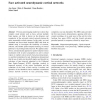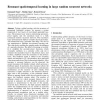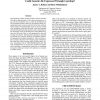14 search results - page 2 / 3 » Learning cortical topography from spatiotemporal stimuli |
MBEC
2011
13 years 20 days ago
2011
Previous neuroimaging studies have shown that complex visual stimuli, such as faces, activate multiple brain regions, yet little is known on the dynamics and complexity of the acti...
BC
2002
13 years 9 months ago
2002
Taking a global analogy with the structure of perceptual biological systems, we present a system composed of two layers of real-valued sigmoidal neurons. The primary layer receives...
ICANN
2010
Springer
13 years 11 months ago
2010
Springer
Learning processes allow the central nervous system to learn relationships between stimuli. Even stimuli from different modalities can easily be associated, and these associations ...
AAAI
2000
13 years 11 months ago
2000
Self-organizing models develop realistic cortical structures when given approximations of the visual environment as input, and are an effective way to model the development of fac...
BC
2005
13 years 9 months ago
2005
Grating cells were discovered in the V1 and V2 areas of the monkey visual cortex by von der Heydt et al. (1992). These cells responded vigorously to grating patterns of appropriate...



